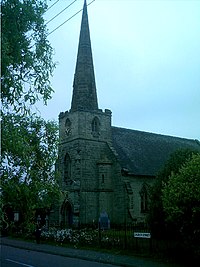Coton-in-the-Elms
| Coton in the Elms | |
|---|---|
 St Mary Church, Coton in the Elms (Built 1844-1847). |
|
| Coton in the Elms shown within Derbyshire | |
| Population | 896 (2011) |
| OS grid reference | SK253144 |
| District | |
| Shire county | |
| Region | |
| Country | England |
| Sovereign state | United Kingdom |
| Post town | SWADLINCOTE |
| Postcode district | DE12 |
| Dialling code | 01283 |
| Police | Derbyshire |
| Fire | Derbyshire |
| Ambulance | East Midlands |
| EU Parliament | East Midlands |
Coton in the Elms is a village and parish in the English county of Derbyshire. At 70 miles from the coast, it is the furthest place in England from the sea. The population of the civil parish as of the 2011 census was 896. It is located 5 miles southwest of Swadlincote and 6 miles south of Burton upon Trent.
Less than a mile southeast of the village is Church Flatts Farm, which is defined by the Ordnance Survey as the furthest point from the sea in Great Britain.
Coton is mentioned over a thousand years ago when land was transferred to Wulfrige the Black in AD942. It is also on the salt route known as Walton Way, which starts in nearby Walton-on-Trent.
Coton in the Elms is mentioned in the Domesday book where it is then spelt Cotes. The book says under the title of “The lands of the Abbey of Burton".
"In Coton in the Elms Ælfgar had two carucates of land to the . There is land for three ploughs. Now the abbot has it of the king. There are now one plough in demesne and six villans and three bordars having two ploughs. TRE worth 40 shillings now 30 shillings."
Coton is situated on the Walton Way and is first mentioned in 942 in a charter giving land in the area to Wulfrige the Black. This formed part of a much larger estate covering many of the villages in the area. Coton would seem to have been roughly in the centre of this estate. It would appear that it was a crossroads as there is an old lane which runs all the way from Tamworth through Coton and on northwards towards Burton on Trent. At the time of Domesday Burton Abbey held land at Coton - however this had been initially seized by King William - no doubt in part due to the rebellion led by Earl Morcar. However, by the time of Domesday this land had been restored to Burton. The village itself forms a diamond of roads around a small village green. The original route of the Walton Way may have been the south west corner of this diamond as this runs past the Church and Church Farm. To the north east of the village coal mining became important and this is reflected in the lane name Coalpit Lane.
...
Wikipedia

